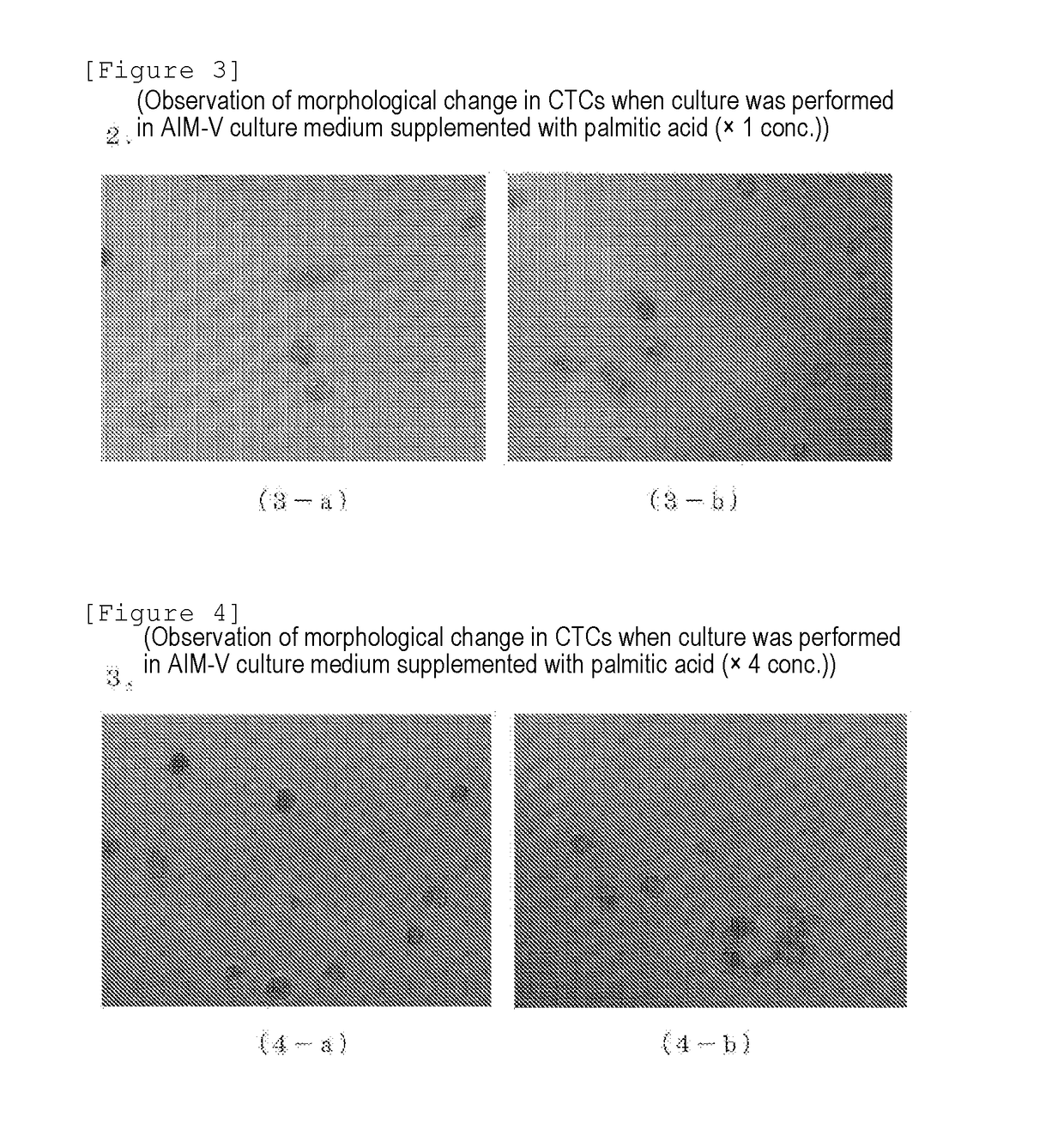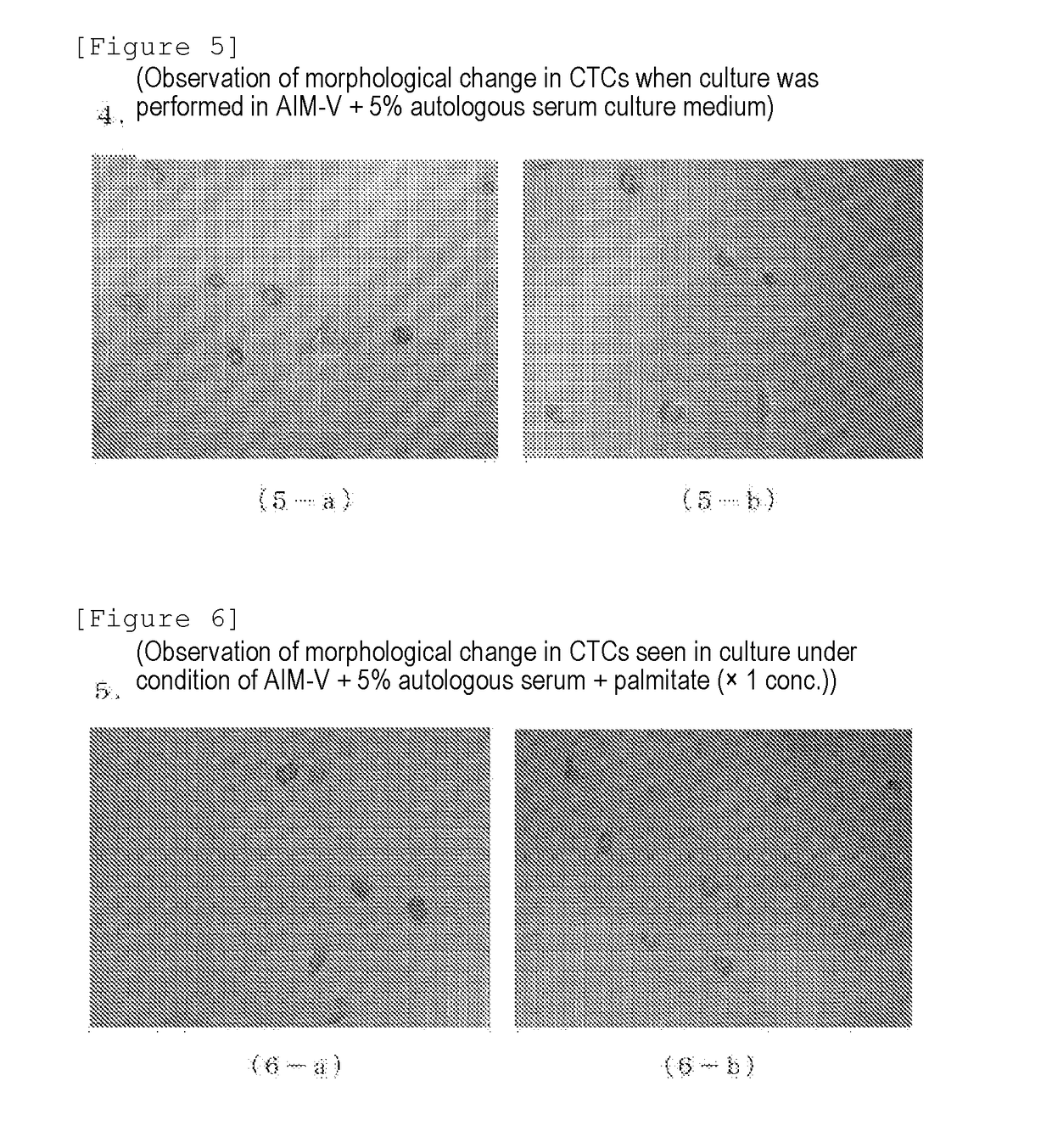Method for detecting or separating/obtaining circulating tumor cell employing cell proliferation method
a cell proliferation and tumor cell technology, applied in tumor/cancer cells, instruments, biochemistry apparatus and processes, etc., can solve the problems of low level of presence of ctcs in blood or the like, insufficient control, and regional lymph node metastasis, so as to achieve efficient and stable isolation of ctcs, reliable and stable detection, and revolutionary headway in research
- Summary
- Abstract
- Description
- Claims
- Application Information
AI Technical Summary
Benefits of technology
Problems solved by technology
Method used
Image
Examples
example 1
Experimental Method
[0101]Examples of the present invention followed experimental methods given below. Specifically, all experimental samples (peripheral blood from various cancer patients who donated blood) were aseptically treated by procedures given below. In the case where infections by various viruses such as HBV and HCV were found in advance according to information from each cooperating facility, the treatment thereof was tested aside from a non-infected group and proper medical waste treatment was carried out by medical waste treatment professionals.
[0102](Collection of Sample: Blood Collection)
1. A disposable 30 ml syringe for blood collection containing an appropriate amount of an anticoagulant heparin sodium (0.05 ml) was provided, and a disposable 30 ml blood collection syringe for serum procurement containing no heparin sodium was also provided. These syringes were respectively connected to insertion ports of L-type 180° three-way stopcock, while an appropriate 18-, 21- ...
example 2
[0114][Selection Test (I) of Efficient Culture Medium for Cancer Cell (CTC) Obtainment]
[0115]
[0116]The following culture media were provided and used as culture media to be tested.
(1) RPMI-1640+5% FBS
[0117](2) RPMI-1640+5% Auto Serum (autologous serum)
(3) AIM-V (serum-free culture medium alone)
(4) AIM-V+5% FBS
[0118](5) AIM-V+5% Auto Serum (autologous serum)
Experimental Method
[0119]Each culture medium was tested for cancer cell (CTC) yield efficiency (cancer cell detection accuracy) according to the experimental method described in Example 1 using the culture media described above.
[0120](Test 1: Study on CTCs-Inducing Ability Using RPMI-1640)
[0121]RPMI-1640 was used as a culture medium, and this was used as a common culture medium. The culture medium was divided into a fetal bovine serum (FBS) supplemented group and an autologous serum (Auto Serum) supplemented group. Samples collected from 6 cancer patients were studied for the presence or absence of the CTCs-inducing ability.
[0122]...
example 3
[0153][Selection Test (II) of Efficient Culture Medium for Cancer Cell (CTC) Obtainment—Influence of Additive]
[0154]
[0155]The following culture media were prepared and used as culture media to be tested.
(1) AIM-V (serum-free culture medium)
(2) AS (Auto Serum: autologous serum)
(3) LPS (lipopolysaccharide)
(4) IL-1α (interleukin 1α)
(5) IL-1β (interleukin 1β)
(6) Palmitic Acid
Experimental Method
[0156]Prepared peripheral blood mononuclear cells (PBMCs) of a cancer patient were seeded to each well according to the experimental method described in Example 1 using the culture media described above, to test the influence of an additive in each culture medium on cancer cell (CTC) yield efficiency (cancer cell detection accuracy).
[0157](Test 8: Influence of LPS Addition to AIM-V Culture Medium)
[0158]An AIM-V culture medium (AIM-V: Group A) was used as a basis. A group in which AS (autologous serum) was added thereto (AIM-V+AS: Group B), and further, groups in which LPS (lipopolysaccharide) was ...
PUM
 Login to View More
Login to View More Abstract
Description
Claims
Application Information
 Login to View More
Login to View More - R&D
- Intellectual Property
- Life Sciences
- Materials
- Tech Scout
- Unparalleled Data Quality
- Higher Quality Content
- 60% Fewer Hallucinations
Browse by: Latest US Patents, China's latest patents, Technical Efficacy Thesaurus, Application Domain, Technology Topic, Popular Technical Reports.
© 2025 PatSnap. All rights reserved.Legal|Privacy policy|Modern Slavery Act Transparency Statement|Sitemap|About US| Contact US: help@patsnap.com



